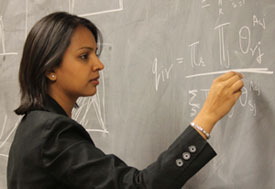Solving a math puzzle to stop infectious disease
September / October 2011 | Volume 10, Issue 5
By Steve Goldstein
Shweta Bansal wants to know where you’ve been. Also, how long you were there and how often and who you might have come into contact with.

Photo courtesy of Dr. Shweta Bansal
With Fogarty support, Dr. Shweta Bansal uses
mathematical models to uncover patterns of human
or animal interaction so disease outbreaks can
prevented or contained.
No, she’s not with the police, but she
is a detective of sorts. And if there is anything she’s hoping to “arrest,” it’s the spread of disease.
Dr. Bansal is a computational mathematician and her research is focused on human ecology and behavior, about how humans interact with social and natural environments and how that impacts and is impacted by infectious disease transmission. She constructs contact network models to create a backbone to show how infectious disease spreads. “It could be by touching a doorknob that has been touched by some with a cold or as well-defined as sexual contact with someone with an STD,” said Bansal.
The modeling reveals patterns of human or animal interaction that allows researchers to recommend points of intervention. This research may assist policymakers in making the right choices that can prevent the spread of disease and save lives.
Bansal, a slim, soft-spoken, India-born and California-raised 30-year-old, is a postdoctoral research fellow with the
Research and Policy for Infectious Disease Dynamics program - RAPIDD. Managed by Fogarty’s Division of International Epidemiology and Population Studies and the U.S. Department of Homeland Security, which provides funding, RAPIDD is designed to improve standards in infectious disease modeling to better inform policy decisions.
Bansal’s work encompasses both direct and vector-borne disease transmission. Currently, she is modeling data on dengue collected in Iquitos, the largest city in the Peruvian rainforest and home to swarms of
Aedes aegypti, the mosquito that is a vector for several tropical fevers.
“With directly transmitted diseases like influenza and measles, we understand that interactions between individuals have the ability to spread disease and are suited to network modeling,” Bansal explained. “With a vector-borne disease there’s another player in the game.”
The goal is to extend the network models used to understand patterns of direct transmission to vector- borne diseases, so that the movement patterns of individuals can be overlaid with the vector to reveal how dengue is spread within the community. This involves using detailed location data including GPS coordinates.
“This is to understand the data and think about where the greatest risk of transmission is and where we might focus our intervention,” said Bansal. With the data collected over 10 years, health authorities can allocate limited spraying resources.
RAPIDD is also concerned with zoonosis, or the spread of disease from non-human animals to humans. Bansal has spent considerable time thinking about livestock diseases, specifically, foot and mouth disease, which are of concern to Homeland Security officials, and how they might jump to other species.
Hollywood has also recently highlighted rapidly transmitted diseases in the thriller
Contagion, which depicts the spread of a deadly airborne flu virus. “Given SARS and H1N1, it’s very timely to talk about pandemics spreading through the globe,” Bansal said.
In fact, her research was inspired by an anecdote from the SARS outbreak in which two infected individuals traveling from Hong Kong to Toronto and Vancouver ended up inciting 200 cases in the one instance and none in the other - all due to different patterns of human interaction.
RAPIDD has been “very much a blessing” for her postdoctoral work, she said. “It focuses on bringing the right expertise together on the mathematical side, the biological side and the public health side and thinking at a fundamental level about infectious disease dynamics,” said Bansal. Although it is a funding program like many others, it is unique in providing a community of world experts who work in concert.
Bansal’s mentor, Princeton University biologist Bryan Grenfell, said of her work: “Network approaches, integrated into other modeling methodologies for disease dynamics, hold great promise for helping us optimize control strategies. Shweta is one of the most original thinkers in this area.”
Next spring, Bansal will be teaching at Georgetown University’s Biology Department, but remains a faculty affiliate with RAPIDD. Look for her on
CSI: Disease.
Bansal, S., Grenfell, B. T., Meyers, L.A. (2007)
When individual behavior matters: homogeneous and network models in epidemiology.
J. R. Soc Interface. Vol 4 (16).
Bansal, S ., Read, J., Pourbohloul, B., Meyers, L.A. (2010)
The dynamic nature of contact networks in epidemiology.
Journal of Biological Dynamics Vol 4 (5).
To view Adobe PDF files,
download current, free accessible plug-ins from Adobe's website.